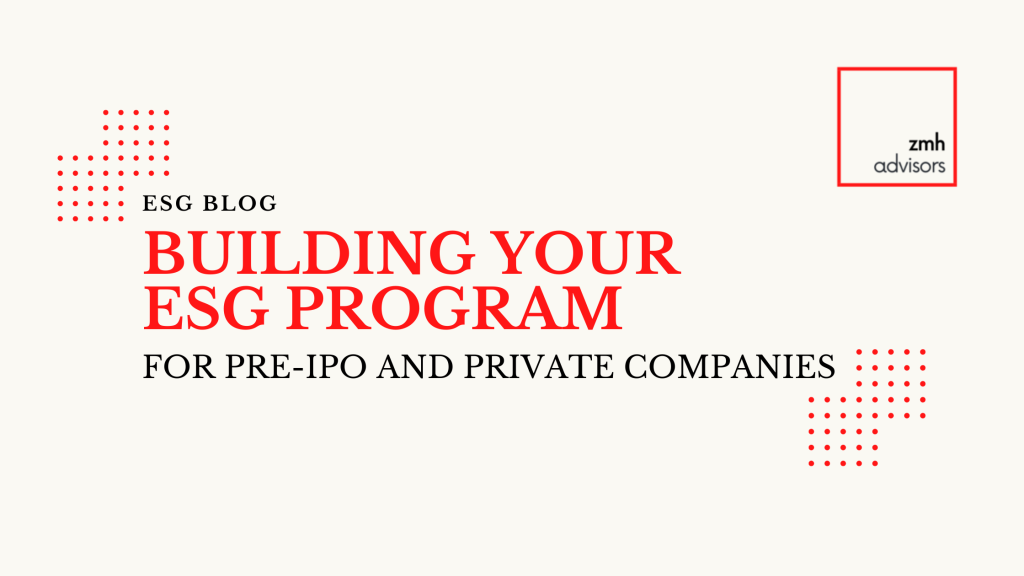Build an ESG program for my private company? Why bother if it isn’t required? These are fair question to ask since building an ESG program doesn’t appear to impact revenue or business operations on its face.
The answer is not that complicated: an ESG program actually can produce net positive impact in terms of increased revenue, reduced costs, and higher investments. There are many opportunities for companies that are ahead of the curve – or even those merely keeping pace – to integrate ESG into their business strategies in a manner that creates value. Climate change isn’t going away. Neither are the concerns over social equity and inclusion.
An ESG program can help build trust to foster employee engagement and retention. It can help a private company partner with the communities in which it operates. And it definitely is a key component of any risk management program.
Probably most important, key customers or suppliers might insist that a private company have a robust ESG program as part of their own Scope 3 emissions evaluation. Not having an ESG program – with its attendant data and policies at the ready – could lead to loss of business, in the form of both existing and potential clients.
Leading private companies are building ESG programs to be a differentiating factor among peers. These companies have placed a high enough value on brand equity and reputation to rationalize the initial investment. ESG is inevitably going to be discussed as part of any stakeholder engagement. And for any private company hoping to one day go public, having an ESG program already in place ahead of that IPO will not only facilitate regulatory compliance, but help to advance discussions with potential investors, particularly institutional funds most of whom have already integrated ESG into their valuation and risk management processes.
Best Practices for ESG Programs in Private Companies
The steps for building an ESG program for a private company are the same as for a public company. They are:
- Conduct an ESG risk assessment – You’ll need to build your ESG team, hopefully led by someone with project management skills. This team will be responsible for establishing your baseline – where you’re at right now – by conducting an ESG risk assessment.
- Establish ESG goals and objectives – Once you know where you are, you want to establish where you want to be going forward. Accordingly, you’ll want to set an ESG strategy along with goals and objectives. You want to be realistic in setting your strategy. But also choose some targets that help you move the needle.
- Engage with stakeholders – To help set your strategy, you should engage with stakeholders. Your key stakeholders at this point are pretty much everyone that has helped you along the way. Your investors, customers, suppliers, employees and the communities in which you operate. When you engage, you want to be thinking of these questions so that you can get answers to them: “What ESG topics matter most to your stakeholders? And what should be the metrics and targets that create the best alignment?”
- Integrate ESG into business processes – Once you know your ESG strategies, you need to integrate them into your overall business processes so that your goals and objectives can be met. You need buy in from your employee base, from your customers and suppliers, so it’s important that senior management and the Board is behind your ESG mission and can communicate that message well.
- Measure and report on ESG progress – Now you need to find out whether your ESG strategy is paying off. Are you meeting your goals and objectives? How can you communicate your progress to? You need measuring and reporting systems in place in order to capture the information needed for this analysis.
Performance Challenges and Considerations
This all is easily said but in actuality it can be challenging to accomplish because nearly all companies continually face headwinds – both foreseen and unforeseen – that make it easy to push ESG to the backburner. In addition, ESG poses issues on its own, including:
- Difficulty finding the proper resources and expertise – ESG is constantly evolving so it can be difficult to find people with the knowledge-base necessary to get your program off the ground fast. Good candidates might not be willing to join a company that hasn’t shown commitment to ESG before. And it can be hard to find service providers who really know what they’re doing. Many providers claim they know ESG as a marketing ploy because it’s such a hot topic at the moment.
- Balancing ESG considerations with other business priorities – For those companies just trying to survive this year, this quarter, ESG doesn’t seem to be something that is a “must do.” That might be true, but some effort can be made by viewing ESG as a business opportunity that can help improve the company’s overall value proposition and long-term viability.
- Managing the costs of ESG initiatives – Here is where a well-executed risk assessment bears fruit. Figuring out what makes sense for your company at this time and hiring providers that are cost-effective is important. You must be realistic in setting goals and objectives.
- Measuring the impact of ESG initiatives and reporting on performance – Once an ESG strategy is set, that doesn’t mean that it shouldn’t be continuously evaluated as to whether that strategy continues to make sense. Adjustments are inevitable. The key is making the time to make those modifications – and making the modifications in a way that benefits the company’s strategy, reputation and bottom line.
ZMH allows you to maximize the ROI on your ESG investment in resources, initiatives and disclosures. We help to:
- Determine key stakeholders and perform materiality assessments;
- Measure and establish data-centric baselines (determine emission boundaries, calculate Scope 1 and 2 emission footprints, etc.);
- Establish ESG goals and objectives;
- Formulate carbon reduction strategy and relevant climate policies; and
- Create an infrastructure that effectively integrates ESG into business process that can evolve with increased measuring, reporting, and policy-enhancing demands.

